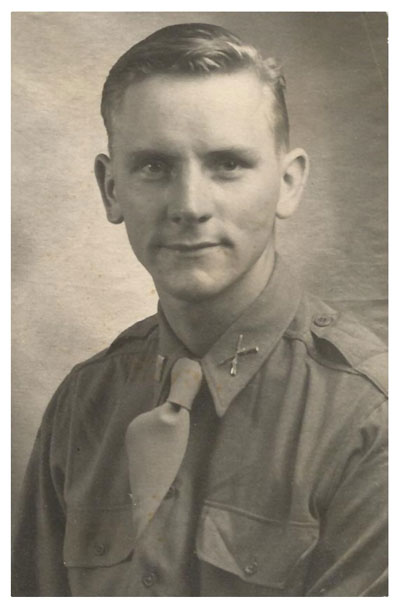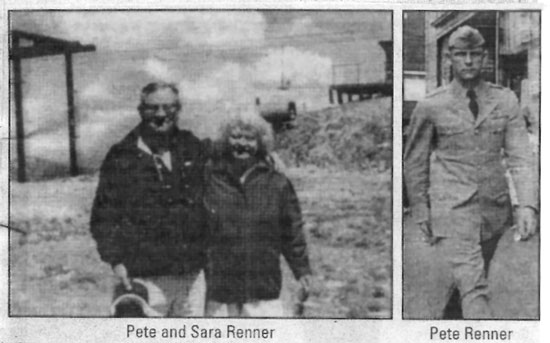 |
134th Infantry Regiment"All Hell Can't Stop Us" |
 |
 |
134th Infantry Regiment"All Hell Can't Stop Us" |
 |

| The following is from an 11 November 2000 Extraordinary People Column by Susan Treu, from a local Milwaukee Area Newspaper (The Milwaukee Journal Sentinel). |
|
Note: During World War II, over 16 million American's served in uniform; more than 400,000 gave their lives. By the time we celebrate another Veteran's Day next November 11, we will have lost another 1,000 of the brave men and women who survived Hitler's wrath - and with them will go a thousand unique stories of courage under adversity. In the next two Extraordinary People columns, you'll read about two of them. The first thing to remember about August Renner is to call him Pete. The second thing to remember is he is a hero. Pete's like the soilder Tom Hanks portrayed in "Saving Private Ryan": a decent, ordinary guy on whose shoulders were placed the weight - and the fate - of the world during the turbulent 1940's. There were thousands of real-life soldiers who became heroes during World War II. Pete is one of them. Before he became a reluctant world traveler, Pete's world was Wauwatosa. The lifelong Tosan lived on 68th Street between Wisconsin Avenue and Bluemound Road. For the last 20 years, he has lived on 74th Street and Maple Terrace. Between those six blocks came marriage, a family, a successful career. Oh, and that little detail of saving the world. When Pete entered World War II in 1943, he was fresh out of Ripon College. He became a member of Patton's Third Army. "We were fighting all the time I was in Europe," he said. Pete fought in the famous Battle of the Bulge in the Belgian town of Bastogne in the winter of 1944. He was the commander of the 124th Infantry (Note 1). "The infantry is the toughest branch - we were sleeping in fox holes in 20 degree weather," he said. "I think I had frostbite when I got hit. You get to the point where you don't give a damn." It was New Year's Eve Day. "Our troop's where surrounded at Bastogne by the Germans in the last major thrust," he said. "I was hit by machine gun fire at close range. It ripped my elbow, knee and one round went right through my chest. There was about 2 feet of snow; I went down, out of sight - I think that's what saved my life." (Note 2). That and some very quick thinking. "My radioman was dead," Pete said. "I grabbed the radio and said they'd need to get a new guy to run this company." Then Pete crawled - head first - pushing along with his good arm and his good leg in the snow along German power lines to get to his troops. It was the longest 20 minutes of his life. "It's like playing a football game - once you're in it," he said. "You do what you're taught to do." His men used tourniquets on all three of Pete's wounds, bundled him up, strapped him to the hood of a jeep and transported him to the hospital. "Those fellas probably saved my life," he said. "I was lucky." Pete spent New Year's Eve of 1944 on the operating table. Three surgeons worked on me at the same time, one on each wound. I was hit at 10 a.m.; they didn't get to me until 10, 11 p.m. "There were hundreds of guy's piled up." For the next 20 months, Pete was bounced around to different Army hospitals, wherever there was a specialist that could treat his different injuries. "I was in a hospital in Paris, France, then South Hampton, then in New York in a body cast, then in Schick General Hospital in Clinton, Iowa - it was the closest hospital to home for what I need done." Pete didn't complain. "I was happy to be alive," he said. Then there was his girl! "While I was in the hospital, she got married to another guy who reminded her of me." Pete was discharged from the service in 1946. For his efforts, he received the Purple Heart, the Bronze Star and "sort of a limp." Pete went back home and then graduate school at the University of Wisconsin - Madison, where he pursued more than a degree in economics and political science. "I found a girl out there, from Green Bay," he said. Her name was Sara and she was a student, too. "She graduated as a journalist," Pete said. "Went to work for the Green Bay Press Gazette as a reporter - until I married her." After that, the big news centered around their children: Nicola, Peter and Glenn - and later, grandchildren. There where world cruises, too - 17 in all. "We were big cruisers," Pete said. In March 1948, Pete cruised into M&I Bank looking for a job. He found it and 39 years later, retired as executive vice president. "I had a great career," he said. Pete has never been among the former servicemen who wanted to return to the shores of France, to relive the time that D-Day troops turned the tide of World War II and saved the world from Nazi domination. "I've never gone back," he said. "Never had the feeling to do that." Pete has read Tom Brokaw's bestseller about his generation, "The Greatest Generation." He's lent it to many of his friends. He recognizes the stories - they happened all around him. But Pete is matter of fact about the sacrifices he and so many of his generation made so that you can complain about taxes and road construction and our own battle of the bulge. "I'll never forget it, but I don't dwell on it either," Pete said. "Either we beat Hitler down or they would have taken over the world. We had to win that war." Notes: 1) Actually Company F of the the 134th Infantry. 2) Acutal town was Lutrebois, Belguim. Only a few miles from Bastone (Referance: 134th Infantry Regiment - Unit Journal 1944-12-31 - 1517 to 1520 hours - Company F reports counterattack on the right flank. The strenght is unknown.) So he was wounded sometime between 1520 hours and 1542 Hours when he was listed on the 134th Infantry Regiment Battle Casualty Report 1945-1-2. |
 |
 |
| Bronze Star Medal Citation |
|
First Lieutenant August N Renner, O536913, Infantry, United States Army, for
heroic service in connection with military operations against an enemy of the
United States near Habkirchen, Germany on 14 and 14 December 1944. When the
Commanding Officer of Company F, 134th Infantry, became a casualty, Lieutenant
Renner assumed command of the unit and successfully led it across the Blies
River and into the woods above the town of Habkirchen. There the company was
subjected to an artillery barrage of such intensity that only twelve men were
left for duty the following morning. It was only through the inspiring
leadership and example of personal bravery on the part of Lieutenant Renner that
the remnant of his company was imbued with an aggressive determination which
enabled it to defend its sector and later participate in a battalion attack
against the enemy. Lieutenant Renner accomplished this task under conditions and
over terrain normally requiring the deployment of a full-strength company. His
brilliant and daring direction of this operation reflects credit upon Lieutenant
Renner's character and training as an officer. Entered military service from
Wisconsin. Headquarters 35th Infantry Division, General Orders No. 6, 15 January 1945 |
Thanks to 1st Lt Renner's nephew, Scott A. Renner, for the newspaper artilcle and the photos.
|
Sign Guestbook
|